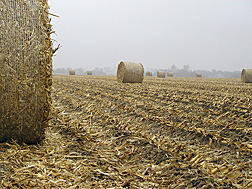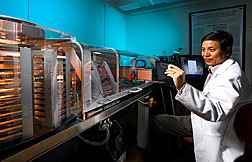Making Bioenergy Yeasts Strong
Your favorite breads and brews may, in part, be the work of the versatile yeast Saccharomyces cerevisiae. In a perhaps lesser known role, this helpful yeast works in fermenters at biorefineries, converting cornstarch, for example, into ethanol.
Tomorrow, improved strains of this yeast might be employed at what are known as “advanced biorefineries.” There, the microbe would help convert rough, fibrous, harvest-time leftovers—such as cornstalks or straw—into cellulosic ethanol.
A renewable fuel, cellulosic ethanol is regarded by many as a cleaner, more environmentally friendly energy source than petroleum, which is nonrenewable.
But life inside a fermenter at an advanced biorefinery wouldn’t necessarily be easy for a yeast.
Perhaps the biggest problem stems from the fact that the agricultural leftovers have to be pretreated before they can be converted into cellulosic ethanol. That step makes it easier to break down the cellulose, hemicellulose, and lignin in plant cell walls, speeding release of simple sugars that are readily fermentable into ethanol. The problem is that the pretreament, done with dilute acid, typically generates compounds that inhibit and stress the yeast, interfering with its ability to do its job.
“These inhibitors are one of the major obstacles to low-cost, large-scale, sustainable production of cellulosic ethanol,” says Zonglin Lewis Liu, a molecular biologist. He’s based at the Agricultural Research Service’s National Center for Agricultural Utilization Research in Peoria, Illinois.
For Hapless Yeasts, Stress Is Serious
Liu says damage caused by two key inhibitors, furfural (short for 2-furaldehyde) and HMF (which stands for 5-hydroxymethyl-2-furaldehyde), is representative of the havoc that inhibitors can wreak on biorefinery yeasts. Inhibitors can damage yeast cell walls and membranes, disrupt yeast genetic material such as DNA and RNA, inhibit yeast growth, and interfere with the fermenting activity of the yeast’s enzymes.
The result?
Yeast performance slows.
Ethanol yields lessen.
Sometimes, the yeast dies.
Remedial steps, such as removing the inhibitors from the fermentation slurry, can reduce their effects. But these options require time and materials and thus add to the overall cost of producing cellulosic ethanol.
“Essentially, removal is economically impractical,” says Liu.
The Quest for Stress-Tolerant Yeasts
Liu and his coresearchers have been tackling this problem since 2003. In one line of study, they have worked with dozens of strains of S. cerevisiae yeasts, housed at the Peoria center’s world-renowned collection of microbes. In their quest for hardier biorefinery yeasts, they have recently focused on NRRL Y-12632, an industrial S. cerevisiae already used for producing ethanol from cornstarch.
Using a laboratory approach known as “evolutionary engineering,” the scientists speeded up the microbe’s natural adaptation to the hostile environment created by the inhibitors. The result is NRRL Y-50049, a promising new yeast for the Peoria collection.
In tests with a 2-liter fermenter, this new strain has demonstrated an impressive ability to shrug off the debilitating effects of furfural and HMF. Further tests with a 100-liter fermenter are planned, says Liu.
The researchers are discovering more about the genes and networks of genes that are likely responsible for the notable tolerance shown by this new yeast.
Liu and colleagues Jaewoong Moon, at Peoria; Mingzhou Song, at New Mexico State University-Las Cruces; and Menggen Ma, previously an ARS research associate affiliated with the university, are curious about these genes. Their discoveries might prove useful in enhancing other promising yeasts for tomorrow’s biorefineries.
Studies by Liu and colleagues suggest that of the nearly 7,000 genes in the S. cerevisiae genome, more than 350 may be involved in counteracting stress. Their work has brought some of these genes, and their complex interactions with many other genes, into sharper focus.
For instance, Liu and the Las Cruces scientists compared the new, stress-tolerant NRRL Y-50049 with its parent, the comparatively stress-intolerant NRRL Y-12632.
What Genes Help New Yeast Handle Stress?
To discover what genes the new strain expresses, or turns on, when it needs to cope with the problematical inhibitors, Liu and colleagues grew cells of both yeasts in their laboratory and exposed the cells to sublethal amounts of furfural and HMF. Using procedures known as a “microarray” and a “qRT-PCR array assay,” they captured what is essentially a series of snapshots of gene responses at different points in time, from 0 through 65 hours. The time-span covered periods of yeast growth and of fermentation performed by the yeast.
In some instances, the new strain turned on certain genes that allowed it to withstand the inhibitors, while the parent strain did not activate those genes. In other instances, the inhibitors successfully repressed certain genes in both strains at early stages of the time-course experiment. However, “genes in the new strain eventually recovered from this lag phase, or downtime,” says Liu. “NRRL Y-50049 adapted, survived, and produced normal yields of ethanol.” In contrast, certain genes in the parent strain did not recover.
Gene Families Get Involved
Details about the most relevant interactions among key stress-tolerance genes are also emerging from the research. Genes and networks of genes that the team has pinpointed as being of major importance include many that act under the influence of YAP1, a master gene.
“We have shown that this gene acts as a regulator that cues interactions of many related genes,” says Liu. “These regulated genes work together, enhancing production of enzymes needed for reducing furfural and HMF into less toxic compounds.”
Also important: Members of the PDRgene family. “PDR1 and PDR3 regulate other genes in the PDR family that help the yeast to pump out the toxins’ harmful byproducts,” Liu explains. “Ridding itself of the byproducts helps the yeast recover and get back to work.”
The genes exert their effects through various molecular pathways. Liu and co-workers have published detailed preliminary diagrams of these pathways for other scientists’ scrutiny.
“This is new knowledge,” Liu says. “We may be able to use it to further improve stress tolerance in NRRL Y-50049 or to develop stress tolerance in other candidate yeast strains.”
Why examine so many genes and their pathways at once?
Says Liu, “It is impossible to fully explain complicated functions such as stress tolerance if you use the single-gene approach. We’ve shown that stress tolerance involves multiple networks of genes and complex interactions of those genes. A single-gene approach would make it too difficult to see the big picture.”
Liu and collaborators pioneered research on yeast’s ability to—while in the fermenter—detoxify inhibitors and ferment sugars to make cellulosic ethanol. This microbial multi-tasking is known as “in situ detoxification.”
The scientists have documented their findings in Applied Biochemistry and Biotechnology, Applied Microbiology and Biotechnology, BMC Genomics, BMC Microbiology, Gene, Industrial Microbiology and Biotechnology, and Molecular Genetics and Genomics.
Development of superior, inhibitor-tolerant yeasts for efficient, economical, and environmentally sound production of cellulosic ethanol “is a hot area of research not only for us, but for academic and industry researchers around the world,” says Liu. “We think our research can help everyone reach this shared goal.”—By Marcia Wood, Agricultural Research Service Information Staff.
This research supports the USDA priority of developing alternative sources of energy and is part of Bioenergy, an ARS national program (#213) described at http://www.ars.usda.gov/research/programs.htm.
Zonglin Lewis Liu is with the USDA-ARS National Center for Agricultural Utilization Research, Bioenergy Research Unit, 1815 N. University St., Peoria, IL 61604-3902; (309) 681-6294.
"Making Bioenergy Yeasts Strong" was published in the August 2011 issue of Agricultural Research magazine.








